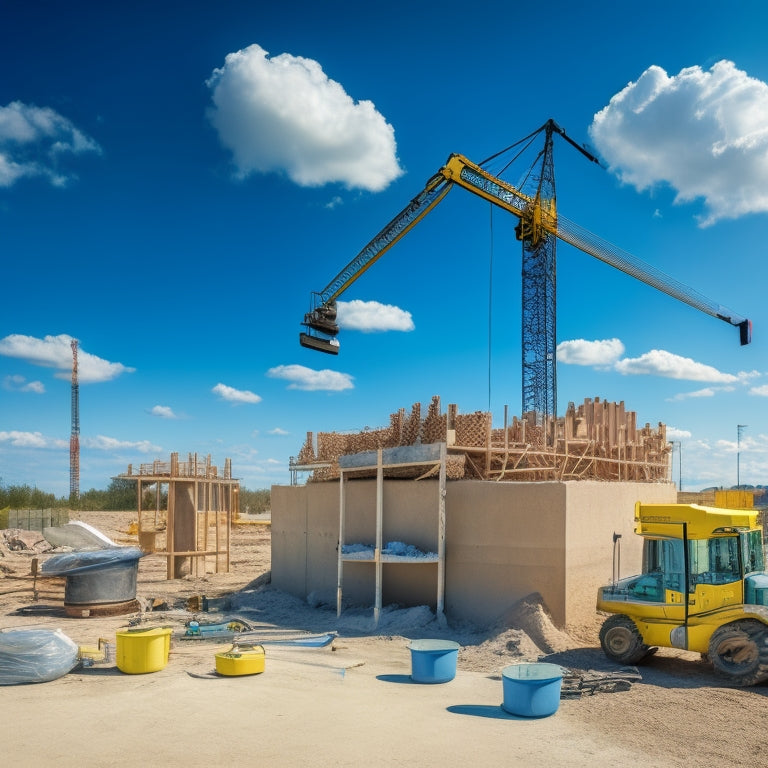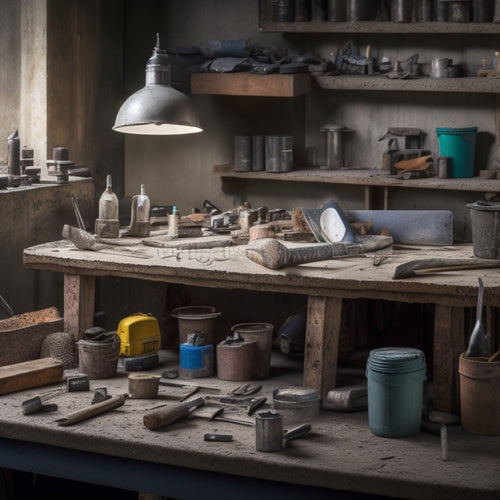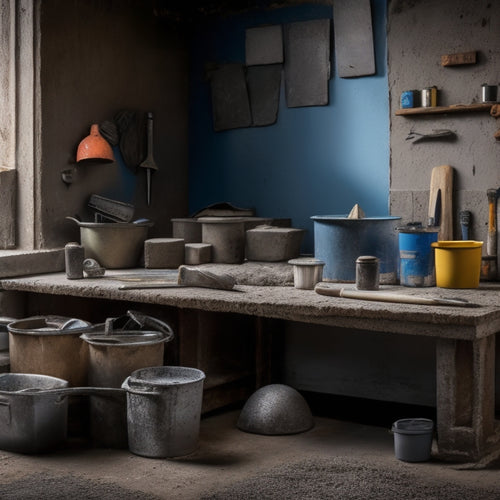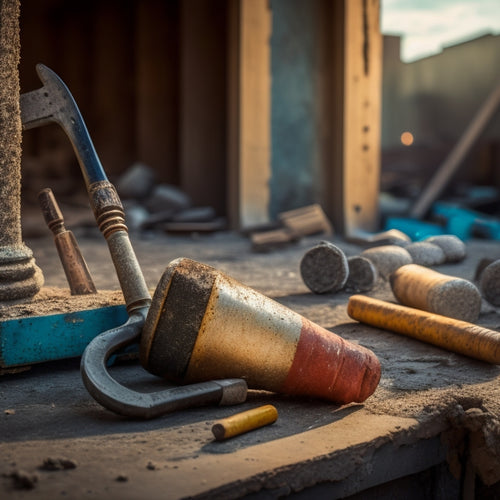
Essential Tools for Building a Concrete Block Structure
Share
When building a concrete block structure, you'll need a range of essential tools to guarantee accuracy, safety, and quality. Start with specialized block laying tools like spirit levels, string lines, and jointing trowels, as well as measuring and leveling tools like high-quality tape measures and laser levels. Mixing and pouring equipment, such as concrete mixers and pouring buckets, are also vital. Don't forget cutting and shaping devices like hand tools, power tools, and masonry saws, as well as tamping and finishing tools like tampers and jointers. With the right tools, you'll be well on your way to building a strong and durable structure - and by exploring further, you'll discover even more nuances to refine your craft.
Key Takeaways
• A spirit level ensures blocks are perfectly horizontal and vertical, while string lines maintain straight lines and even courses during block placement.
• High-quality measuring and leveling tools, such as a laser level and sturdy spirit level, ensure a solid foundation for the structure.
• A concrete mixer, pouring bucket or chute, and tamping tool are essential for mixing and pouring high-quality concrete into block cavities.
• Cutting and shaping devices, including hand tools like a hammer and chisel, and power tools like a circular saw, are necessary for precise cuts and shapes.
• Tamping and finishing tools, such as a tamper or joint tamper, and finishing tools like a jointer, shape and smooth mortar joints for a watertight seal.
Block Laying Essential Tools
You'll need a set of specialized tools to guarantee accurate and efficient block laying, including a spirit level, string lines, and a jointing trowel. These tools will help you achieve precise block alignment and even mortar distribution, making certain a strong and durable structure.
When it comes to block laying techniques, having the right tools is vital. A spirit level guarantees that your blocks are perfectly horizontal and vertical, while string lines guide you in maintaining straight lines and even courses. A jointing trowel, on the other hand, allows you to fill joints accurately and efficiently.
In addition to these essential tools, you'll also need to take into account the type of block mortar you're using. Different block mortar types, such as Type S or Type N, have specific requirements for mixing and application. By choosing the right mortar type for your project, you can make sure that your blocks are securely held in place and that your structure can withstand various environmental conditions.
Mixing and Pouring Equipment
With block laying underway, turning your attention to mixing and pouring equipment is vital, as it directly impacts the structural integrity of your concrete block structure.
You'll need the right tools to guarantee that your concrete is mixed and poured correctly, resulting in a strong and durable structure.
To achieve this, you'll require:
-
A concrete mixer, which can be a drum-style mixer or a tow-behind mixer, depending on the size of your project.
-
A pouring bucket or chute, which allows you to accurately pour the mixed concrete into the block cavities.
-
A tamping tool, such as a screed board or tamping rod, to guarantee the concrete is evenly distributed and compacted.
Mastering mixing techniques and pouring methods is essential to producing high-quality concrete blocks.
By using the right equipment and techniques, you'll be able to achieve a consistent mix, reduce waste, and minimize the risk of defects.
With the right mixing and pouring equipment, you'll be well on your way to building a strong and durable concrete block structure that meets your design specifications.
Safety Gear and Accessories
As you prepare to lay concrete blocks, don't overlook the importance of donning the right safety gear and accessories to protect yourself from potential hazards on the job site.
Safety training is vital to understanding the risks involved and taking necessary precautions. Before starting the project, make certain you have the required protective equipment, including hard hats, safety glasses, earplugs, and dust masks. These will shield you from falling objects, flying debris, and airborne particles.
Wear steel-toed boots with good traction to prevent slips and falls. Gloves with grip will help you maintain a firm hold on blocks and tools. Don't forget to wear long sleeves and pants to protect your skin from abrasions and cuts.
Additionally, consider investing in a first-aid kit and a fire extinguisher to be prepared for emergencies. By prioritizing safety, you'll be able to focus on building a sturdy and durable concrete block structure.
Measuring and Leveling Tools
Accurate measurements and leveled surfaces are crucial to building a solid concrete block structure, so it's important to have reliable measuring and leveling tools at your disposal.
As you begin your project, you'll need to verify that your blocks are aligned properly and your walls are straight. To achieve this, you'll need a few essential tools.
Here are some must-haves for measuring and leveling:
-
A high-quality tape measure that can withstand the rigors of your job site
-
A laser level that projects a precise, level line to guide your block placement
-
A sturdy spirit level that helps you check the accuracy of your work
With these tools, you'll be able to accurately measure and level your concrete block structure, guaranteeing a solid foundation for your project.
Don't skimp on these essentials – the accuracy and precision they provide will pay off in the long run.
Cutting and Shaping Devices
You'll need to cut and shape concrete blocks to fit around corners, curves, and other obstructions, making cutting and shaping devices essential components of your toolkit. These devices enable you to achieve precise cuts and shapes, ensuring a sturdy and well-structured concrete block building.
For block shaping, you'll require a combination of hand tools, such as a hammer, chisel, and trowel, to manually shape and trim blocks. Additionally, power tools like a circular saw or a masonry grinder can be used for more complex cuts and shapes.
When it comes to cutting accuracy, tips such as marking the block carefully, using a straightedge, and making slow, controlled cuts will help you achieve precise results. Moreover, mastering block shaping techniques, such as splitting blocks or creating curved cuts, will give you the flexibility to build complex structures with ease.
Masonry Saws and Blades
Masonry saws, designed specifically for cutting through concrete, stone, and brick, are high-torque machines that efficiently power through dense materials, making them an indispensable component of your concrete block building toolkit.
You'll need a reliable masonry saw to make precise cuts and maintain a high level of productivity.
When selecting a masonry saw, consider the following factors:
-
Power source: Choose between electric, gas, or hydraulic-powered saws, depending on your specific needs and preferences.
-
Blade selection: Select blades designed for your specific material type, such as diamond-edged blades for concrete or segmented blades for stone.
-
Masonry saw maintenance: Regularly clean and lubricate your saw to prevent overheating and prolong its lifespan.
To guarantee peak performance, it's vital to follow proper masonry saw maintenance and blade selection tips.
By doing so, you'll be able to make precise cuts, reduce downtime, and achieve a professional finish.
With the right masonry saw and blades, you'll be well on your way to building a sturdy and durable concrete block structure.
Tamping and Finishing Tools
With your concrete blocks cut to size, it's time to focus on compacting and finishing the joints between them using specialized tamping and finishing tools. You'll need a tamper or joint tamper to compact the mortar and guarantee a strong bond between the blocks.
This is where tamping techniques come into play. You'll want to use a gentle but firm motion to avoid displacing the mortar, working from the bottom up to prevent air pockets from forming.
Next, you'll need to finish the joints using a finishing tool, such as a jointer or finishing trowel. Finishing methods involve applying a thin layer of mortar to the joint, then using the tool to smooth and shape it to the desired profile.
This is essential for creating a watertight seal and achieving a professional-looking finish. Remember to work in small sections, cleaning your tools frequently to prevent mortar from drying on them.
Hand Tools for Block Handling
When building a concrete block structure, you'll need to handle blocks efficiently and safely.
You'll learn how to lift blocks correctly, using techniques that prevent strain and injury.
Block Lifting Techniques
You'll need to employ proper block lifting techniques to guarantee safe and efficient handling of concrete blocks during construction. This is vital to prevent injuries and secure the structural integrity of your concrete block structure.
When it comes to block lifting techniques, you should prioritize block lifting safety above all else. Here are some essential considerations to keep in mind:
-
Bend at the knees: Avoid straining your back by lifting with your legs, keeping the block close to your body.
-
Get a firm grip: Hold the block securely with both hands, making sure not to touch any sharp edges.
-
Lift in one motion: Use your leg muscles to lift the block in one smooth motion, avoiding any jerky movements.
Tamping and Aligning
Now that you've mastered block lifting techniques, it's time to focus on the tools that'll help you achieve a solid foundation: tamping and aligning concrete blocks with precision requires the right hand tools. You'll need a combination of tamping and aligning tools to guarantee a level and plumb structure.
| Tool | Description |
|---|---|
| Tamping Bar | A long, sturdy bar used to compact and level concrete blocks |
| Alignment Strings | Thin, taut strings used to guarantee blocks are aligned and plumb |
| Leveling Trowel | A tool used to spread and level mortar, guaranteeing a smooth surface |
| Block Aligner | A device that helps maintain alignment and spacing between blocks |
When it comes to tamping techniques, you'll want to use a combination of gentle and firm taps to compact the blocks. For alignment methods, use your level and alignment strings to guarantee blocks are straight and level. By mastering these techniques and using the right hand tools, you'll be able to build a solid, long-lasting concrete block structure. Remember to always follow safety guidelines and manufacturer instructions when using these tools.
Power Tools for Block Cutting
Two essential power tools for cutting concrete blocks efficiently are a rotary hammer drill and a masonry saw.
These power tools will enable you to master various block cutting techniques, ensuring precise cuts and minimizing waste. A rotary hammer drill is ideal for drilling holes for anchors or pipes, while a masonry saw is perfect for making straight cuts in blocks.
When using these power tools, it's vital to maintain them properly to extend their lifespan.
Here are some tips to keep in mind:
-
Regularly clean the tools to prevent dust and debris buildup
-
Lubricate moving parts to reduce wear and tear
-
Store tools in a dry, secure location to prevent damage
Specialized Equipment Needs
When building a concrete block structure, you'll need to contemplate investing in specialized equipment to streamline your workflow and guarantee precision.
You'll require machines that can efficiently lay blocks, mix and pump concrete, and cut blocks to size.
These tools will help you achieve professional results and meet project deadlines.
Block Laying Machines
How efficiently can you lay concrete blocks without the right machinery, considering the labor-intensive nature of the task and the need for precision and speed in large-scale construction projects?
Block laying machines are a game-changer in this regard, revolutionizing block laying techniques and reaping numerous block laying benefits. These machines automate the process, guaranteeing accuracy, consistency, and speed.
Here are some key features of block laying machines:
-
Increased productivity: Lay multiple blocks per minute, considerably reducing construction time and labor costs.
-
Improved accuracy: Precise block alignment and placement guarantee a sturdy and even structure.
-
Enhanced safety: Reduce the risk of injury and fatigue associated with manual block laying.
Mixing and Pumping Systems
You'll need specialized equipment, specifically mixing and pumping systems, to efficiently produce and transport high-quality concrete for your block structure. These systems are essential for achieving the right consistency and strength for your concrete blocks. When it comes to mixing, you'll need to take into account the type of mixer, mixing techniques, and the order of ingredient addition to guarantee a consistent and homogeneous mix.
| Mixing Technique | Advantages | Pumping Efficiency |
|---|---|---|
| Drum Mixing | Fast and easy to use | High, suitable for large projects |
| Pan Mixing | Good for small batches | Medium, suitable for small projects |
| Twin-Shaft Mixing | High-quality mix, low maintenance | Very High, suitable for large and complex projects |
| Single-Shaft Mixing | Cost-effective, easy to maintain | Medium, suitable for small to medium projects |
| Volumetric Mixing | High accuracy, low waste | High, suitable for large and complex projects |
When selecting a pumping system, take into account the distance and height you need to pump the concrete, as well as the pressure and flow rate required. By choosing the right mixing and pumping systems, you'll be able to produce high-quality concrete blocks efficiently and effectively.
Concrete Block Cutters
To achieve precise cuts and uniform block sizes, specialized concrete block cutters are essential for processing and finishing your concrete blocks. These cutters are designed to handle the unique demands of concrete block applications, guaranteeing accurate cuts and minimizing waste.
When it comes to block cutting techniques, you'll want to invest in a high-quality concrete block cutter that can handle various block sizes and types. Here are some key features to reflect on:
-
Automatic cutting systems: These systems use advanced sensors and algorithms to guarantee precise cuts, reducing labor time and increasing productivity.
-
Diamond-coated blades: These blades are designed for durability and precision, providing clean cuts and minimizing dust generation.
-
Adjustable cutting heads: These heads allow for flexibility in cutting different block sizes and angles, making them ideal for complex concrete block structures.
Frequently Asked Questions
Can I Use Regular Cement Instead of Specialized Block Cement?
When building, you'll wonder if regular cement suffices, but specialized block cement's unique properties guarantee superior block durability; using regular cement may compromise strength, so it's worth investing in the right type for a robust structure.
How Do I Ensure the Structure Can Withstand Natural Disasters?
You'll guarantee your structure withstands natural disasters by incorporating seismic reinforcement, which enhances load distribution, and designing a robust foundation that anchors the blocks securely, allowing the structure to flex and absorb seismic forces.
Are There Any Eco-Friendly Alternatives to Traditional Concrete Blocks?
You're looking for eco-friendly alternatives to traditional concrete blocks. Consider using sustainable materials like fly ash or slag cement, and recycled aggregates like crushed glass or recycled concrete to reduce your structure's carbon footprint.
Can I Build a Concrete Block Structure Without Professional Experience?
Imagine yourself constructing a concrete block masterpiece, but can you do it without professional experience? Yes, you can, by mastering DIY techniques and prioritizing structural safety to guarantee your project stands strong and sturdy.
How Long Does It Take for Concrete Blocks to Fully Cure?
You'll need to wait 28 days for concrete blocks to fully cure, as the curing process depends on moisture control, with ideal conditions requiring 90% relative humidity and temperatures between 50°F and 80°F.
Conclusion
You've got the blueprints, the materials, and the know-how, but without the right tools, your concrete block structure won't get off the ground.
Don't assume you can wing it with makeshift equipment - it's a recipe for disaster.
Invest in the essentials, and you'll avoid costly delays, guarantee quality, and maintain safety.
Remember, the right tools aren't an expense, they're an investment in your project's success.
Related Posts
-

Top Tools for Concrete Repair Success
When it comes to concrete repair success, you'll need a well-stocked toolkit with essential hand tools like trowels, ...
-

Top Tools for Beginners in Concrete Masonry Coating
You're about to begin a concrete masonry coating project, and having the right tools is essential. Start with essenti...
-

5 Tips for Splitting Concrete With Second-Hand Tools
When splitting concrete with second-hand tools, you'll need to be strategic to avoid wasting time, money, and putting...


